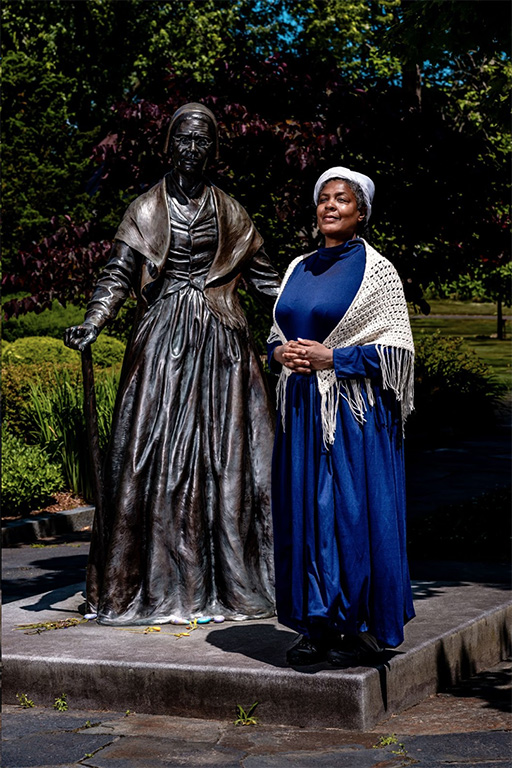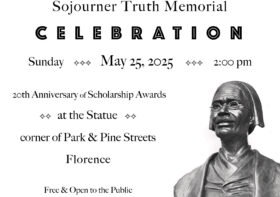Celebrating Sojourner Truth, with modern elements: Florence performance mixes arias, history and AR

Sojourner Truth has long been a symbol of a strong Black woman: a straight-talking, formerly enslaved woman who remade herself as an ardent abolitionist and women’s rights activist, a preacher, and a riveting speaker who wowed audiences with her wit and cadences.
But because Truth could neither write nor read, her initial story was recorded mostly by white women, who at times spun her narrative for their own purposes, in some cases giving her a southern accent or saying she escaped from slavery in the South, though Truth was actually born and first enslaved in New York state.
As Bonita Oliver sees it, there’s a need today to take a fresh look at Truth, not just as a symbol but as a person, one who did more to shape her own image than many realize and who encouraged people to take charge of their own lives.
Oliver, a New York multidisciplinary artist who grew up in Springfield, will explore some of those themes when she debuts a new project June 15 at 3 p.m. at the Sojourner Truth Memorial in Florence — original arias she’s composed about the abolitionist and speaker that will be accompanied by augmented reality (AR) images.
“AR Arias: Sojourner Truth, Part 1,” which will be presented in cooperation with the Sojourner Truth Memorial Committee, is the first part of a series of performances Oliver hopes to bring to other historic sites around the country that honor Truth.
“This is a different way to delve into her life and tell her stories with integrity,” said Oliver, who in addition to her work as a vocalist and composer is involved with visual art and theatrical presentations.
The four arias she’s composed for her June 15 performance, which are also designed to recognize Juneteenth on June 19, are based on chapters from Truth’s life that occurred during the years she lived in Florence, from about 1844 to 1857.
One aria, for instance, examines her purchase of a house in Florence, and another looks at a famous speech she gave at a women’s rights convention in Ohio in 1851, which was transcribed and published several years later by a white abolitionist, Frances Dana Barker Gage.
Historians say publication of what’s known as Truth’s “Ain’t I a Woman?” speech was deeply inaccurate, as Gage had Truth speaking in a southern vernacular she never used; Gage also embellished Truth’s presentation in other ways.
“A lot of the work I do is about finding ways we can reclaim our own voices, and I’m interested in showing how Sojourner’s story has been told over the years,” Oliver said.
Along with her arias, Oliver says the AR images she’s created for the June 15 performance, which can be accessed on cell phones via Instagram — she’ll supply a QR code for that to audience members — are designed to look at aspects of Truth’s life from a different angle.
“I’m looking at how the technology can be used in ways that enrich and amplify her story, and not distance us from it,” she said, adding that her presentation will have some interactive elements.
Oliver notes that at Truth’s later speaking engagements, the abolitionist “curated her own image” by selling small postcards, known as cartes de visite, that displayed different photos of her and included the phrase “I sell the shadow to support the substance.”
In a sense, notes Oliver, Truth was using a 19th century version of AR to tell her story.
“That was one way she could take charge of her own image and her story,” said Oliver. “She was very much about doing things on your own and not asking other people to do things for you … that’s one of the reasons I’m passionate about telling her story.”
Oliver’s presentation at the Sojourner Truth Memorial is free and will last about half and hour. Oliver will be available for questions and discussion after her performance. Her website is bonitaoliver.com.
Background Note: AR Arias: Sojourner Truth is a site specific series of performances honoring the life and legacy of Sojourner Truth. Creator, Bonita Oliver premiered the work here at the Sojourner Truth Memorial on June 15th 2024 to an enthusiastic crowd of all ages. During the event, Bonita performed a few of the arias delivered from Sojourner's imagined perspective about the discrepancies found in the historical record. One such aria addresses Frances Gage regarding her transcription of Sojourner's famous Ain't I a Woman speech. Bonita also spoke about the importance of our digital legacy and referencing primary source materials when it comes to history education.
The AR Arias: Sojourner Truth Memorial performance in Florence, MA received funding from OPERA America’s IDEA Opera Grants program, supported by the Charles and Cerise Jacobs Charitable Foundation.
Steve Pfarrer can be reached at spfarrer@gazettenet.com.


